Human Rights Violations and the Plight of Widows in India: A Study
VerifiedAdded on 2023/06/10
|68
|18374
|60
Report
AI Summary
This report investigates the challenges faced by widows in India, focusing on the violation of their human rights and the social discrimination they encounter. The research employs a descriptive design, utilizing both primary and secondary data collection methods, including surveys of 100 widows and interviews with human rights department managers. The findings reveal that widows continue to experience social cruelty and discrimination, leading to a poor societal standing. The report highlights issues such as social exclusion, financial insecurity, and the violation of fundamental human rights. It also explores the historical context and cultural practices that contribute to the marginalization of widows, such as being seen as a burden and facing restrictions on diet and lifestyle. The research further examines the role of NGOs and governmental initiatives in supporting widows and addresses the legal protections available to them. Ultimately, the report provides recommendations for addressing the challenges faced by widows and reducing the violation of their human rights, emphasizing the need for effective laws and social support systems.
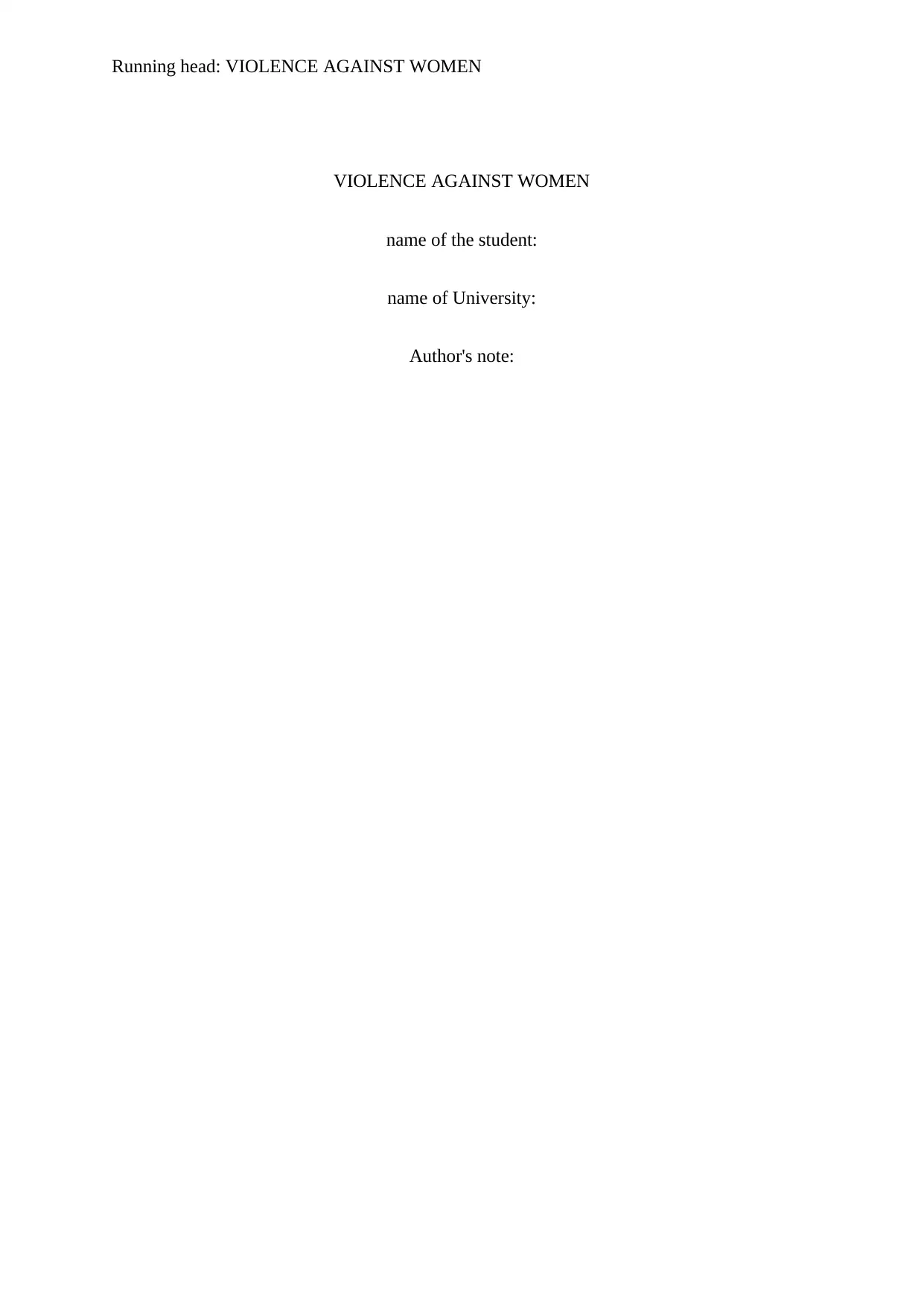
Running head: VIOLENCE AGAINST WOMEN
VIOLENCE AGAINST WOMEN
name of the student:
name of University:
Author's note:
VIOLENCE AGAINST WOMEN
name of the student:
name of University:
Author's note:
Paraphrase This Document
Need a fresh take? Get an instant paraphrase of this document with our AI Paraphraser
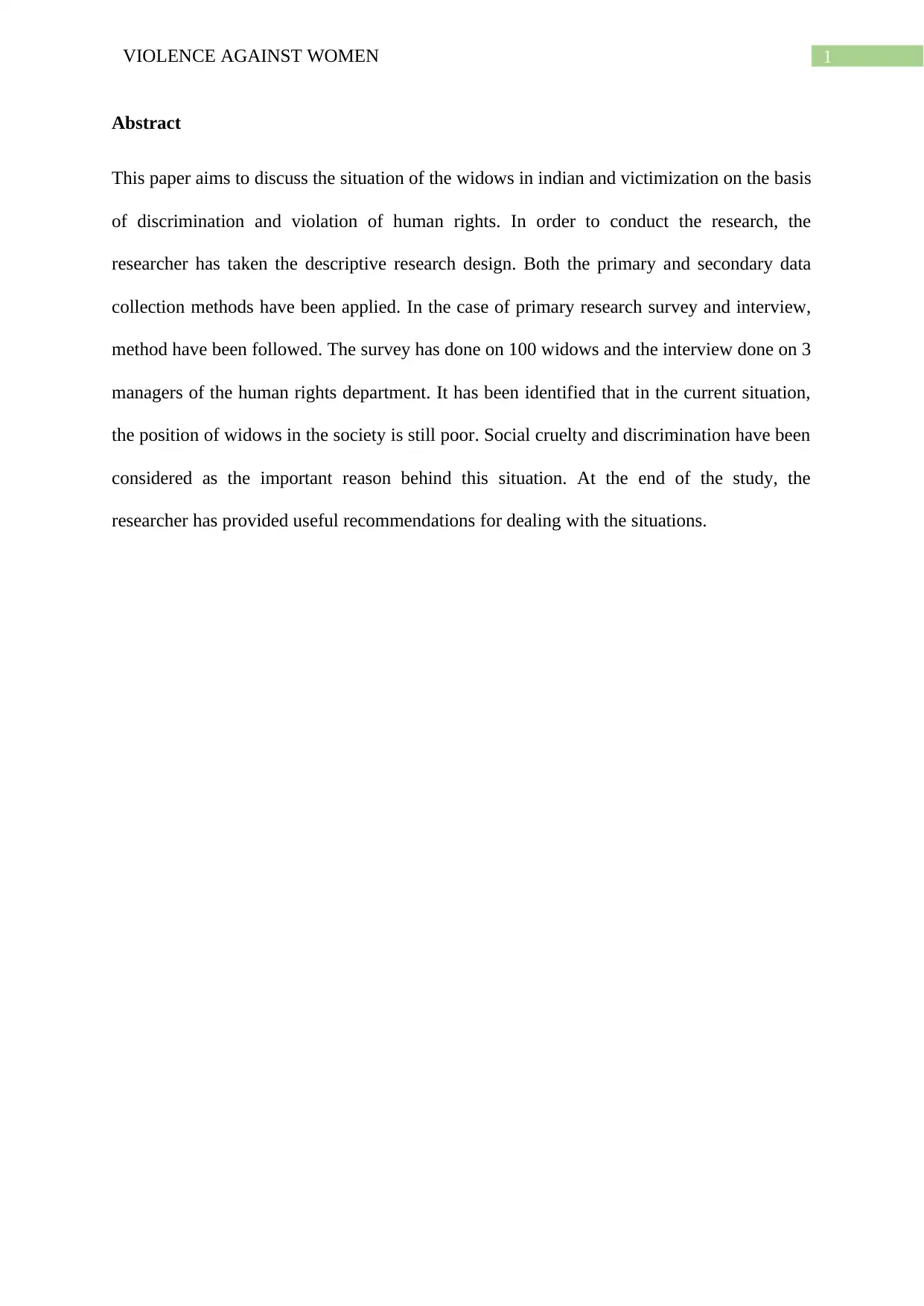
1VIOLENCE AGAINST WOMEN
Abstract
This paper aims to discuss the situation of the widows in indian and victimization on the basis
of discrimination and violation of human rights. In order to conduct the research, the
researcher has taken the descriptive research design. Both the primary and secondary data
collection methods have been applied. In the case of primary research survey and interview,
method have been followed. The survey has done on 100 widows and the interview done on 3
managers of the human rights department. It has been identified that in the current situation,
the position of widows in the society is still poor. Social cruelty and discrimination have been
considered as the important reason behind this situation. At the end of the study, the
researcher has provided useful recommendations for dealing with the situations.
Abstract
This paper aims to discuss the situation of the widows in indian and victimization on the basis
of discrimination and violation of human rights. In order to conduct the research, the
researcher has taken the descriptive research design. Both the primary and secondary data
collection methods have been applied. In the case of primary research survey and interview,
method have been followed. The survey has done on 100 widows and the interview done on 3
managers of the human rights department. It has been identified that in the current situation,
the position of widows in the society is still poor. Social cruelty and discrimination have been
considered as the important reason behind this situation. At the end of the study, the
researcher has provided useful recommendations for dealing with the situations.
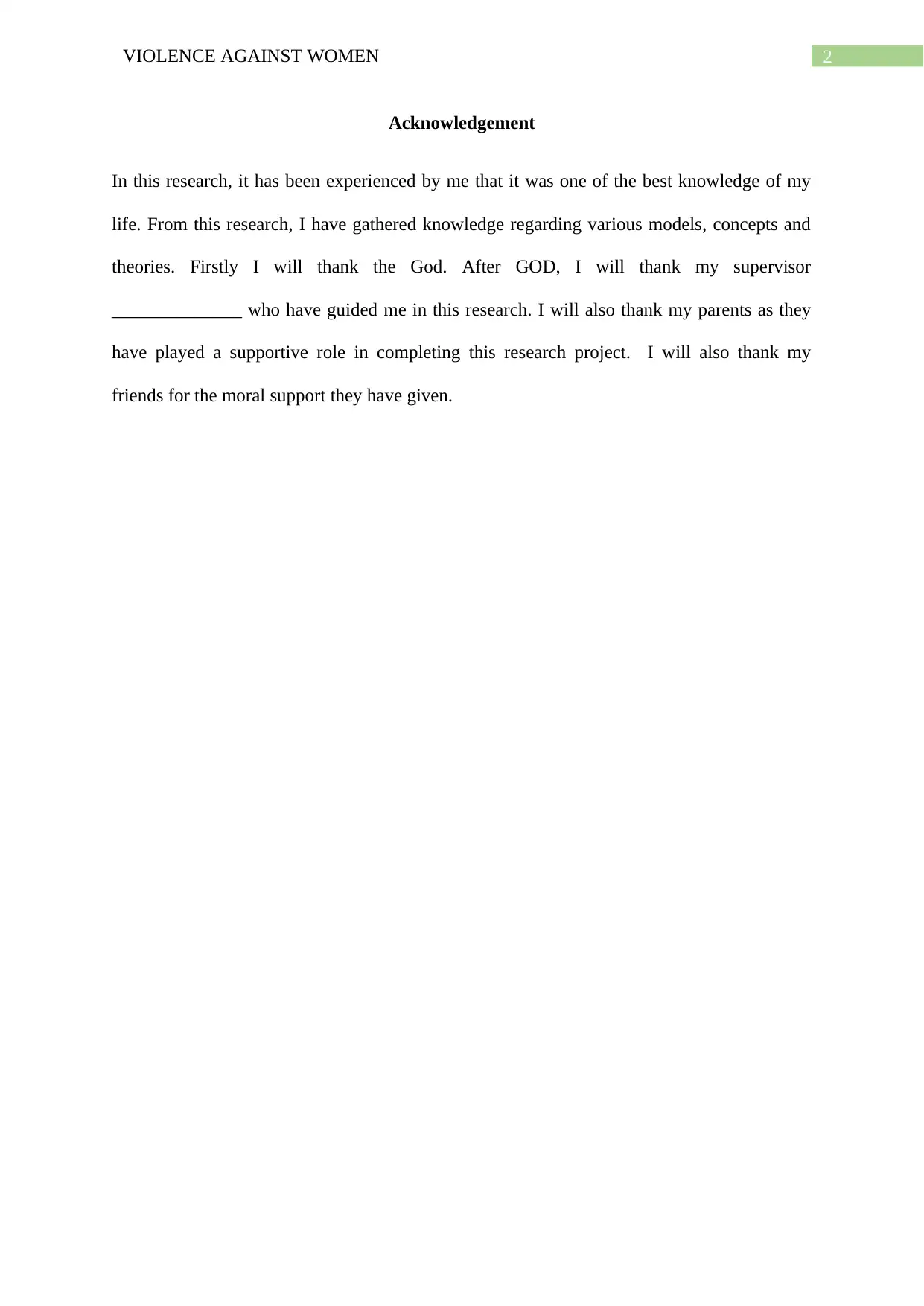
2VIOLENCE AGAINST WOMEN
Acknowledgement
In this research, it has been experienced by me that it was one of the best knowledge of my
life. From this research, I have gathered knowledge regarding various models, concepts and
theories. Firstly I will thank the God. After GOD, I will thank my supervisor
______________ who have guided me in this research. I will also thank my parents as they
have played a supportive role in completing this research project. I will also thank my
friends for the moral support they have given.
Acknowledgement
In this research, it has been experienced by me that it was one of the best knowledge of my
life. From this research, I have gathered knowledge regarding various models, concepts and
theories. Firstly I will thank the God. After GOD, I will thank my supervisor
______________ who have guided me in this research. I will also thank my parents as they
have played a supportive role in completing this research project. I will also thank my
friends for the moral support they have given.
⊘ This is a preview!⊘
Do you want full access?
Subscribe today to unlock all pages.

Trusted by 1+ million students worldwide
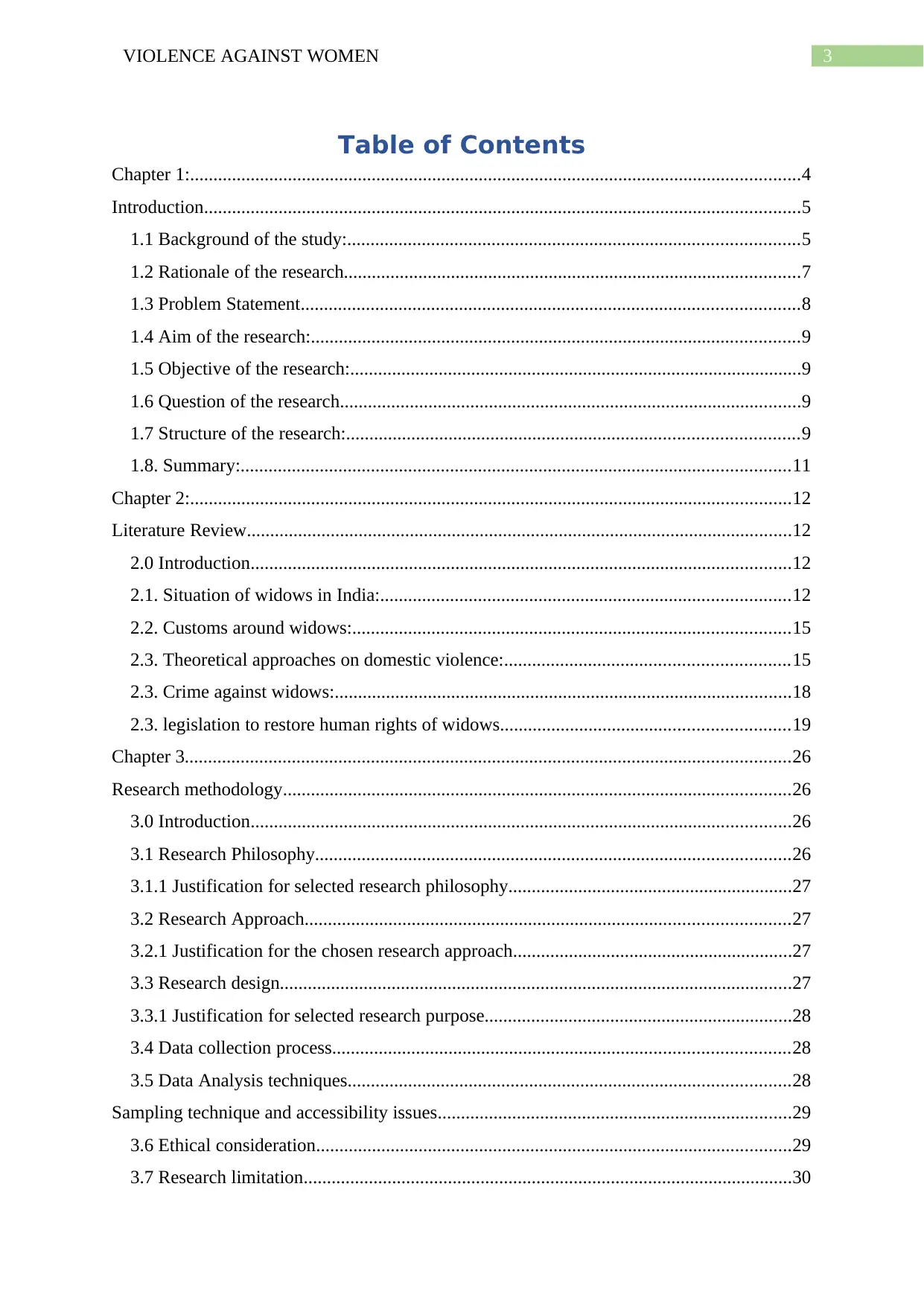
3VIOLENCE AGAINST WOMEN
Table of Contents
Chapter 1:...................................................................................................................................4
Introduction................................................................................................................................5
1.1 Background of the study:.................................................................................................5
1.2 Rationale of the research..................................................................................................7
1.3 Problem Statement...........................................................................................................8
1.4 Aim of the research:.........................................................................................................9
1.5 Objective of the research:.................................................................................................9
1.6 Question of the research...................................................................................................9
1.7 Structure of the research:.................................................................................................9
1.8. Summary:......................................................................................................................11
Chapter 2:.................................................................................................................................12
Literature Review.....................................................................................................................12
2.0 Introduction....................................................................................................................12
2.1. Situation of widows in India:........................................................................................12
2.2. Customs around widows:..............................................................................................15
2.3. Theoretical approaches on domestic violence:.............................................................15
2.3. Crime against widows:..................................................................................................18
2.3. legislation to restore human rights of widows..............................................................19
Chapter 3..................................................................................................................................26
Research methodology.............................................................................................................26
3.0 Introduction....................................................................................................................26
3.1 Research Philosophy......................................................................................................26
3.1.1 Justification for selected research philosophy.............................................................27
3.2 Research Approach........................................................................................................27
3.2.1 Justification for the chosen research approach............................................................27
3.3 Research design..............................................................................................................27
3.3.1 Justification for selected research purpose..................................................................28
3.4 Data collection process..................................................................................................28
3.5 Data Analysis techniques...............................................................................................28
Sampling technique and accessibility issues............................................................................29
3.6 Ethical consideration......................................................................................................29
3.7 Research limitation.........................................................................................................30
Table of Contents
Chapter 1:...................................................................................................................................4
Introduction................................................................................................................................5
1.1 Background of the study:.................................................................................................5
1.2 Rationale of the research..................................................................................................7
1.3 Problem Statement...........................................................................................................8
1.4 Aim of the research:.........................................................................................................9
1.5 Objective of the research:.................................................................................................9
1.6 Question of the research...................................................................................................9
1.7 Structure of the research:.................................................................................................9
1.8. Summary:......................................................................................................................11
Chapter 2:.................................................................................................................................12
Literature Review.....................................................................................................................12
2.0 Introduction....................................................................................................................12
2.1. Situation of widows in India:........................................................................................12
2.2. Customs around widows:..............................................................................................15
2.3. Theoretical approaches on domestic violence:.............................................................15
2.3. Crime against widows:..................................................................................................18
2.3. legislation to restore human rights of widows..............................................................19
Chapter 3..................................................................................................................................26
Research methodology.............................................................................................................26
3.0 Introduction....................................................................................................................26
3.1 Research Philosophy......................................................................................................26
3.1.1 Justification for selected research philosophy.............................................................27
3.2 Research Approach........................................................................................................27
3.2.1 Justification for the chosen research approach............................................................27
3.3 Research design..............................................................................................................27
3.3.1 Justification for selected research purpose..................................................................28
3.4 Data collection process..................................................................................................28
3.5 Data Analysis techniques...............................................................................................28
Sampling technique and accessibility issues............................................................................29
3.6 Ethical consideration......................................................................................................29
3.7 Research limitation.........................................................................................................30
Paraphrase This Document
Need a fresh take? Get an instant paraphrase of this document with our AI Paraphraser
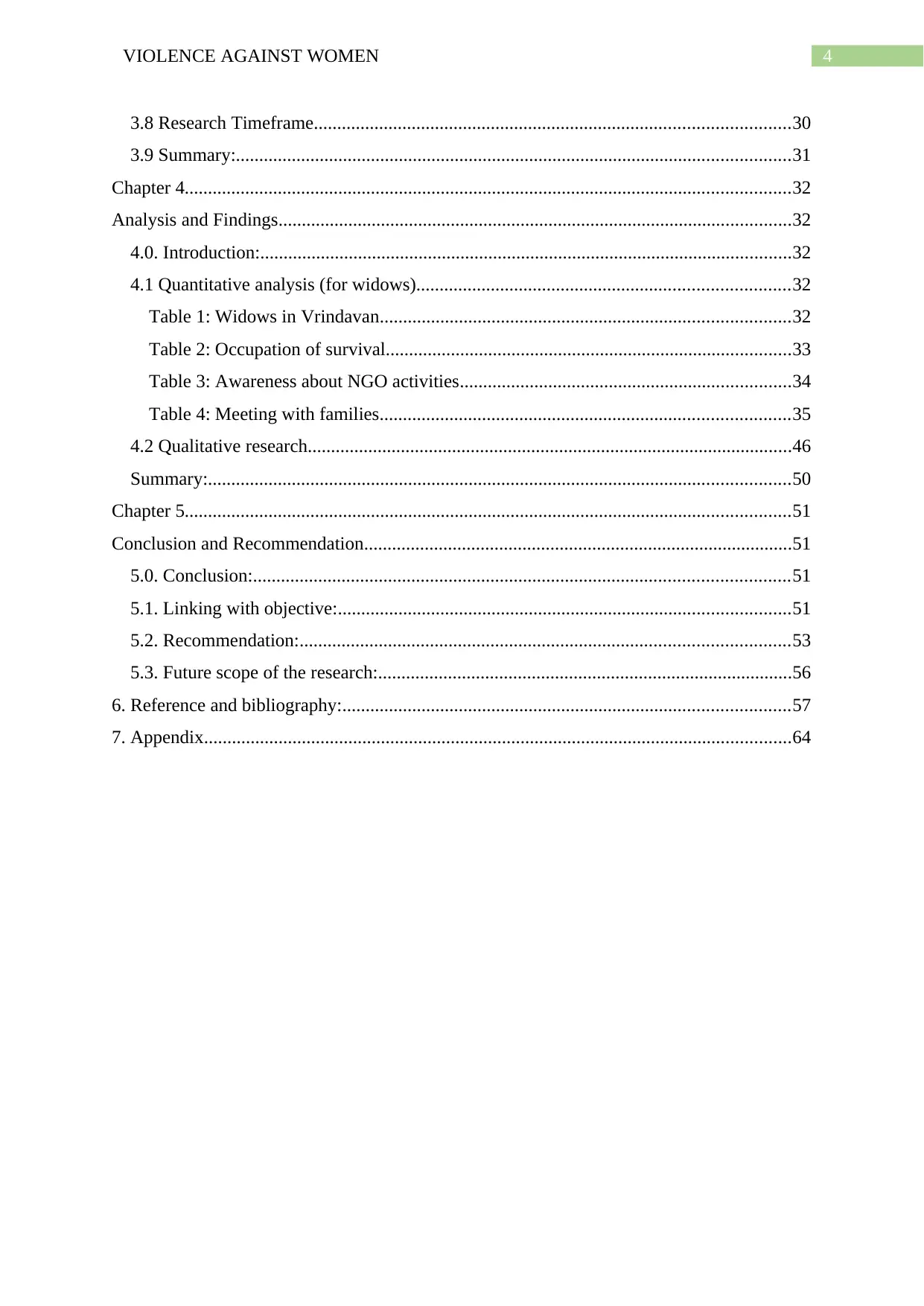
4VIOLENCE AGAINST WOMEN
3.8 Research Timeframe......................................................................................................30
3.9 Summary:.......................................................................................................................31
Chapter 4..................................................................................................................................32
Analysis and Findings..............................................................................................................32
4.0. Introduction:..................................................................................................................32
4.1 Quantitative analysis (for widows)................................................................................32
Table 1: Widows in Vrindavan........................................................................................32
Table 2: Occupation of survival.......................................................................................33
Table 3: Awareness about NGO activities.......................................................................34
Table 4: Meeting with families........................................................................................35
4.2 Qualitative research........................................................................................................46
Summary:.............................................................................................................................50
Chapter 5..................................................................................................................................51
Conclusion and Recommendation............................................................................................51
5.0. Conclusion:...................................................................................................................51
5.1. Linking with objective:.................................................................................................51
5.2. Recommendation:.........................................................................................................53
5.3. Future scope of the research:.........................................................................................56
6. Reference and bibliography:................................................................................................57
7. Appendix..............................................................................................................................64
3.8 Research Timeframe......................................................................................................30
3.9 Summary:.......................................................................................................................31
Chapter 4..................................................................................................................................32
Analysis and Findings..............................................................................................................32
4.0. Introduction:..................................................................................................................32
4.1 Quantitative analysis (for widows)................................................................................32
Table 1: Widows in Vrindavan........................................................................................32
Table 2: Occupation of survival.......................................................................................33
Table 3: Awareness about NGO activities.......................................................................34
Table 4: Meeting with families........................................................................................35
4.2 Qualitative research........................................................................................................46
Summary:.............................................................................................................................50
Chapter 5..................................................................................................................................51
Conclusion and Recommendation............................................................................................51
5.0. Conclusion:...................................................................................................................51
5.1. Linking with objective:.................................................................................................51
5.2. Recommendation:.........................................................................................................53
5.3. Future scope of the research:.........................................................................................56
6. Reference and bibliography:................................................................................................57
7. Appendix..............................................................................................................................64
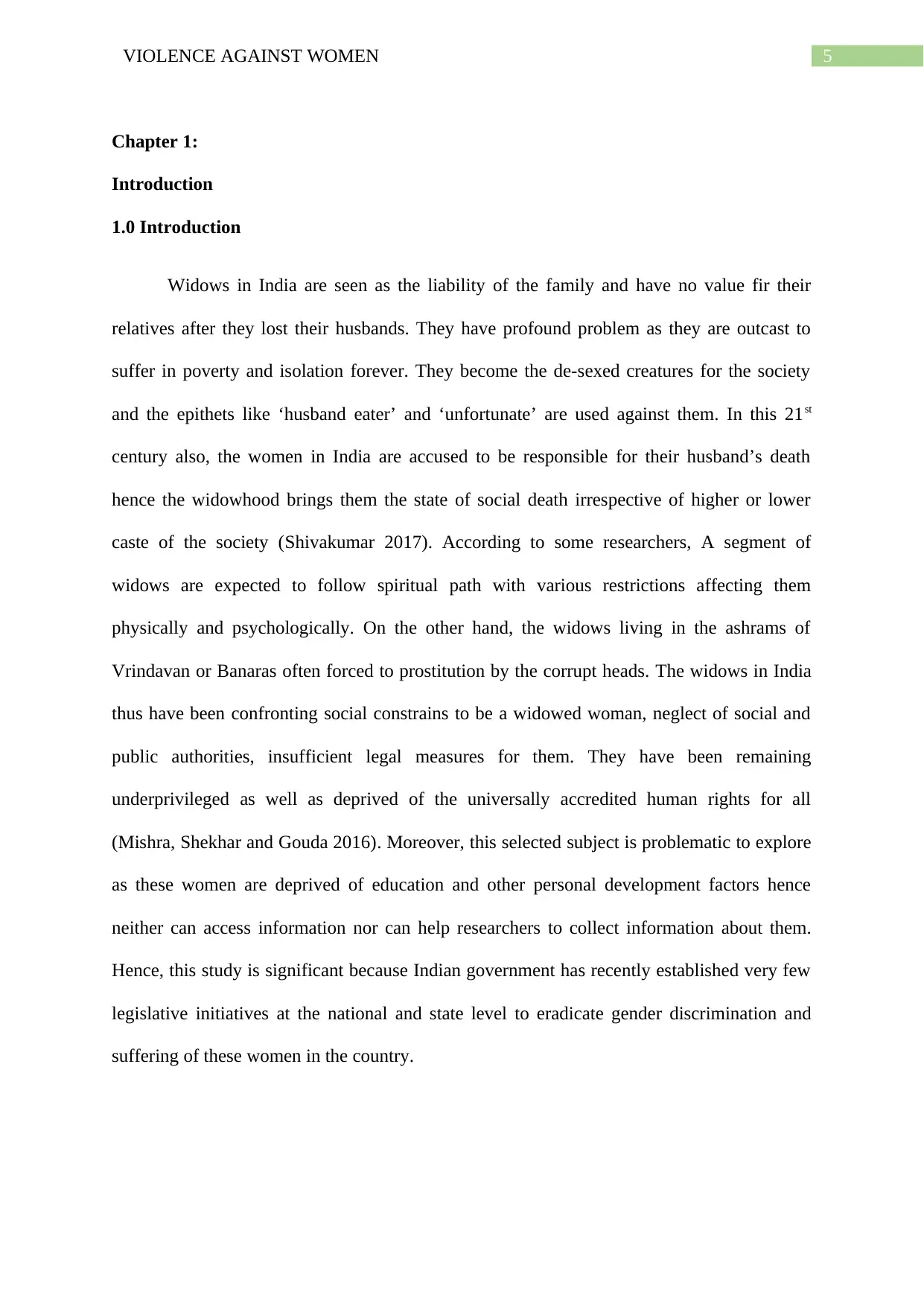
5VIOLENCE AGAINST WOMEN
Chapter 1:
Introduction
1.0 Introduction
Widows in India are seen as the liability of the family and have no value fir their
relatives after they lost their husbands. They have profound problem as they are outcast to
suffer in poverty and isolation forever. They become the de-sexed creatures for the society
and the epithets like ‘husband eater’ and ‘unfortunate’ are used against them. In this 21st
century also, the women in India are accused to be responsible for their husband’s death
hence the widowhood brings them the state of social death irrespective of higher or lower
caste of the society (Shivakumar 2017). According to some researchers, A segment of
widows are expected to follow spiritual path with various restrictions affecting them
physically and psychologically. On the other hand, the widows living in the ashrams of
Vrindavan or Banaras often forced to prostitution by the corrupt heads. The widows in India
thus have been confronting social constrains to be a widowed woman, neglect of social and
public authorities, insufficient legal measures for them. They have been remaining
underprivileged as well as deprived of the universally accredited human rights for all
(Mishra, Shekhar and Gouda 2016). Moreover, this selected subject is problematic to explore
as these women are deprived of education and other personal development factors hence
neither can access information nor can help researchers to collect information about them.
Hence, this study is significant because Indian government has recently established very few
legislative initiatives at the national and state level to eradicate gender discrimination and
suffering of these women in the country.
Chapter 1:
Introduction
1.0 Introduction
Widows in India are seen as the liability of the family and have no value fir their
relatives after they lost their husbands. They have profound problem as they are outcast to
suffer in poverty and isolation forever. They become the de-sexed creatures for the society
and the epithets like ‘husband eater’ and ‘unfortunate’ are used against them. In this 21st
century also, the women in India are accused to be responsible for their husband’s death
hence the widowhood brings them the state of social death irrespective of higher or lower
caste of the society (Shivakumar 2017). According to some researchers, A segment of
widows are expected to follow spiritual path with various restrictions affecting them
physically and psychologically. On the other hand, the widows living in the ashrams of
Vrindavan or Banaras often forced to prostitution by the corrupt heads. The widows in India
thus have been confronting social constrains to be a widowed woman, neglect of social and
public authorities, insufficient legal measures for them. They have been remaining
underprivileged as well as deprived of the universally accredited human rights for all
(Mishra, Shekhar and Gouda 2016). Moreover, this selected subject is problematic to explore
as these women are deprived of education and other personal development factors hence
neither can access information nor can help researchers to collect information about them.
Hence, this study is significant because Indian government has recently established very few
legislative initiatives at the national and state level to eradicate gender discrimination and
suffering of these women in the country.
⊘ This is a preview!⊘
Do you want full access?
Subscribe today to unlock all pages.

Trusted by 1+ million students worldwide
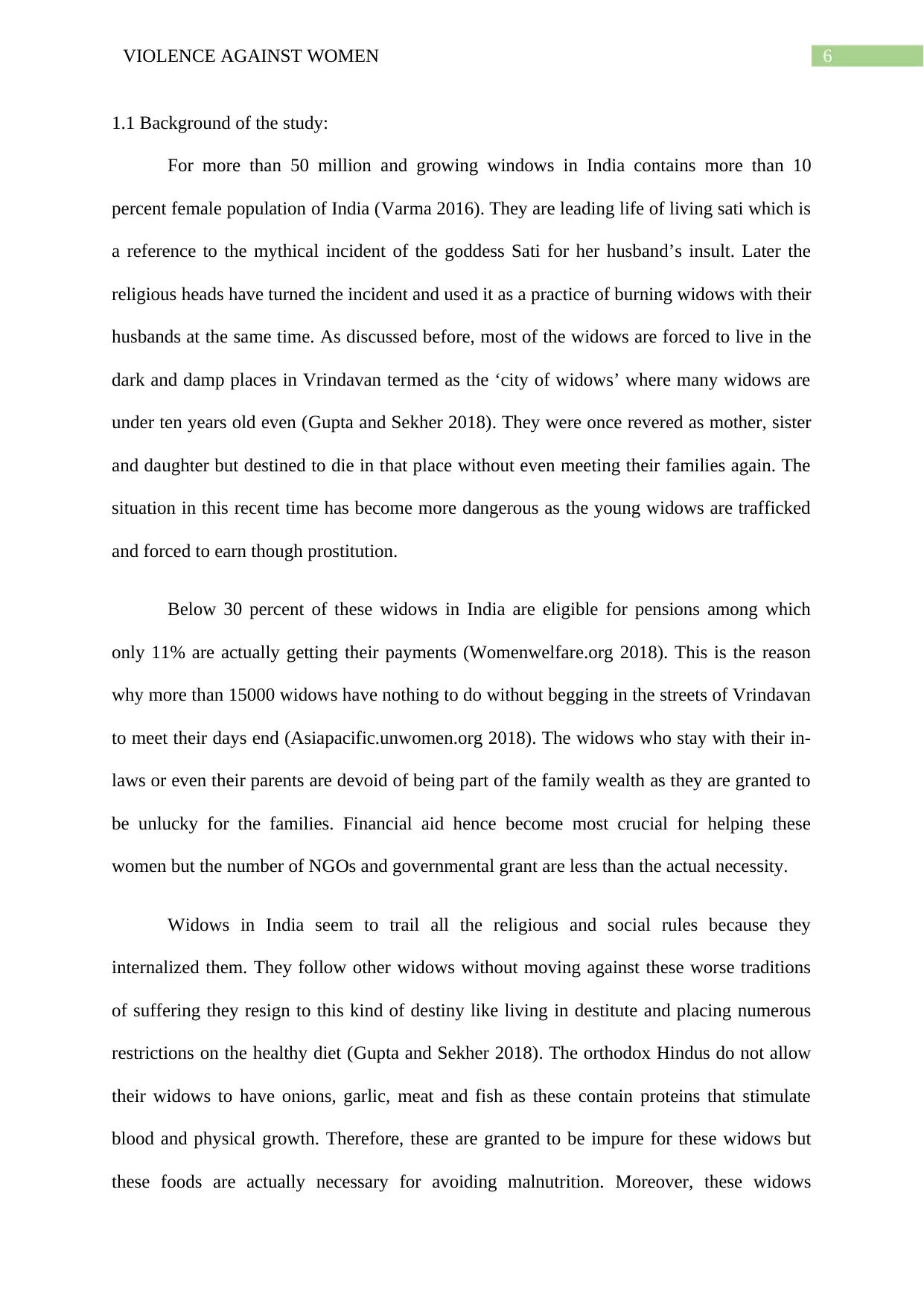
6VIOLENCE AGAINST WOMEN
1.1 Background of the study:
For more than 50 million and growing windows in India contains more than 10
percent female population of India (Varma 2016). They are leading life of living sati which is
a reference to the mythical incident of the goddess Sati for her husband’s insult. Later the
religious heads have turned the incident and used it as a practice of burning widows with their
husbands at the same time. As discussed before, most of the widows are forced to live in the
dark and damp places in Vrindavan termed as the ‘city of widows’ where many widows are
under ten years old even (Gupta and Sekher 2018). They were once revered as mother, sister
and daughter but destined to die in that place without even meeting their families again. The
situation in this recent time has become more dangerous as the young widows are trafficked
and forced to earn though prostitution.
Below 30 percent of these widows in India are eligible for pensions among which
only 11% are actually getting their payments (Womenwelfare.org 2018). This is the reason
why more than 15000 widows have nothing to do without begging in the streets of Vrindavan
to meet their days end (Asiapacific.unwomen.org 2018). The widows who stay with their in-
laws or even their parents are devoid of being part of the family wealth as they are granted to
be unlucky for the families. Financial aid hence become most crucial for helping these
women but the number of NGOs and governmental grant are less than the actual necessity.
Widows in India seem to trail all the religious and social rules because they
internalized them. They follow other widows without moving against these worse traditions
of suffering they resign to this kind of destiny like living in destitute and placing numerous
restrictions on the healthy diet (Gupta and Sekher 2018). The orthodox Hindus do not allow
their widows to have onions, garlic, meat and fish as these contain proteins that stimulate
blood and physical growth. Therefore, these are granted to be impure for these widows but
these foods are actually necessary for avoiding malnutrition. Moreover, these widows
1.1 Background of the study:
For more than 50 million and growing windows in India contains more than 10
percent female population of India (Varma 2016). They are leading life of living sati which is
a reference to the mythical incident of the goddess Sati for her husband’s insult. Later the
religious heads have turned the incident and used it as a practice of burning widows with their
husbands at the same time. As discussed before, most of the widows are forced to live in the
dark and damp places in Vrindavan termed as the ‘city of widows’ where many widows are
under ten years old even (Gupta and Sekher 2018). They were once revered as mother, sister
and daughter but destined to die in that place without even meeting their families again. The
situation in this recent time has become more dangerous as the young widows are trafficked
and forced to earn though prostitution.
Below 30 percent of these widows in India are eligible for pensions among which
only 11% are actually getting their payments (Womenwelfare.org 2018). This is the reason
why more than 15000 widows have nothing to do without begging in the streets of Vrindavan
to meet their days end (Asiapacific.unwomen.org 2018). The widows who stay with their in-
laws or even their parents are devoid of being part of the family wealth as they are granted to
be unlucky for the families. Financial aid hence become most crucial for helping these
women but the number of NGOs and governmental grant are less than the actual necessity.
Widows in India seem to trail all the religious and social rules because they
internalized them. They follow other widows without moving against these worse traditions
of suffering they resign to this kind of destiny like living in destitute and placing numerous
restrictions on the healthy diet (Gupta and Sekher 2018). The orthodox Hindus do not allow
their widows to have onions, garlic, meat and fish as these contain proteins that stimulate
blood and physical growth. Therefore, these are granted to be impure for these widows but
these foods are actually necessary for avoiding malnutrition. Moreover, these widows
Paraphrase This Document
Need a fresh take? Get an instant paraphrase of this document with our AI Paraphraser
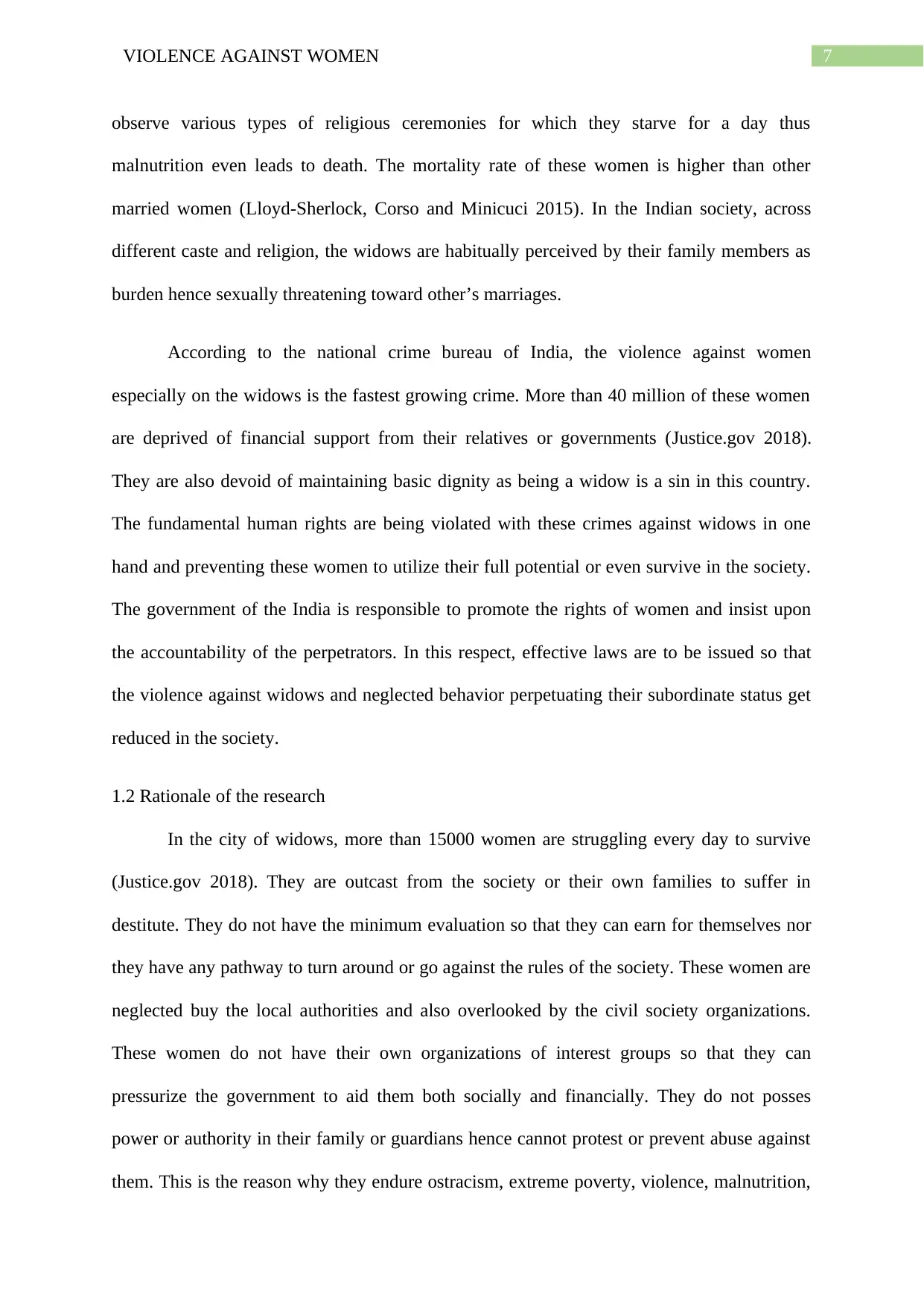
7VIOLENCE AGAINST WOMEN
observe various types of religious ceremonies for which they starve for a day thus
malnutrition even leads to death. The mortality rate of these women is higher than other
married women (Lloyd-Sherlock, Corso and Minicuci 2015). In the Indian society, across
different caste and religion, the widows are habitually perceived by their family members as
burden hence sexually threatening toward other’s marriages.
According to the national crime bureau of India, the violence against women
especially on the widows is the fastest growing crime. More than 40 million of these women
are deprived of financial support from their relatives or governments (Justice.gov 2018).
They are also devoid of maintaining basic dignity as being a widow is a sin in this country.
The fundamental human rights are being violated with these crimes against widows in one
hand and preventing these women to utilize their full potential or even survive in the society.
The government of the India is responsible to promote the rights of women and insist upon
the accountability of the perpetrators. In this respect, effective laws are to be issued so that
the violence against widows and neglected behavior perpetuating their subordinate status get
reduced in the society.
1.2 Rationale of the research
In the city of widows, more than 15000 women are struggling every day to survive
(Justice.gov 2018). They are outcast from the society or their own families to suffer in
destitute. They do not have the minimum evaluation so that they can earn for themselves nor
they have any pathway to turn around or go against the rules of the society. These women are
neglected buy the local authorities and also overlooked by the civil society organizations.
These women do not have their own organizations of interest groups so that they can
pressurize the government to aid them both socially and financially. They do not posses
power or authority in their family or guardians hence cannot protest or prevent abuse against
them. This is the reason why they endure ostracism, extreme poverty, violence, malnutrition,
observe various types of religious ceremonies for which they starve for a day thus
malnutrition even leads to death. The mortality rate of these women is higher than other
married women (Lloyd-Sherlock, Corso and Minicuci 2015). In the Indian society, across
different caste and religion, the widows are habitually perceived by their family members as
burden hence sexually threatening toward other’s marriages.
According to the national crime bureau of India, the violence against women
especially on the widows is the fastest growing crime. More than 40 million of these women
are deprived of financial support from their relatives or governments (Justice.gov 2018).
They are also devoid of maintaining basic dignity as being a widow is a sin in this country.
The fundamental human rights are being violated with these crimes against widows in one
hand and preventing these women to utilize their full potential or even survive in the society.
The government of the India is responsible to promote the rights of women and insist upon
the accountability of the perpetrators. In this respect, effective laws are to be issued so that
the violence against widows and neglected behavior perpetuating their subordinate status get
reduced in the society.
1.2 Rationale of the research
In the city of widows, more than 15000 women are struggling every day to survive
(Justice.gov 2018). They are outcast from the society or their own families to suffer in
destitute. They do not have the minimum evaluation so that they can earn for themselves nor
they have any pathway to turn around or go against the rules of the society. These women are
neglected buy the local authorities and also overlooked by the civil society organizations.
These women do not have their own organizations of interest groups so that they can
pressurize the government to aid them both socially and financially. They do not posses
power or authority in their family or guardians hence cannot protest or prevent abuse against
them. This is the reason why they endure ostracism, extreme poverty, violence, malnutrition,
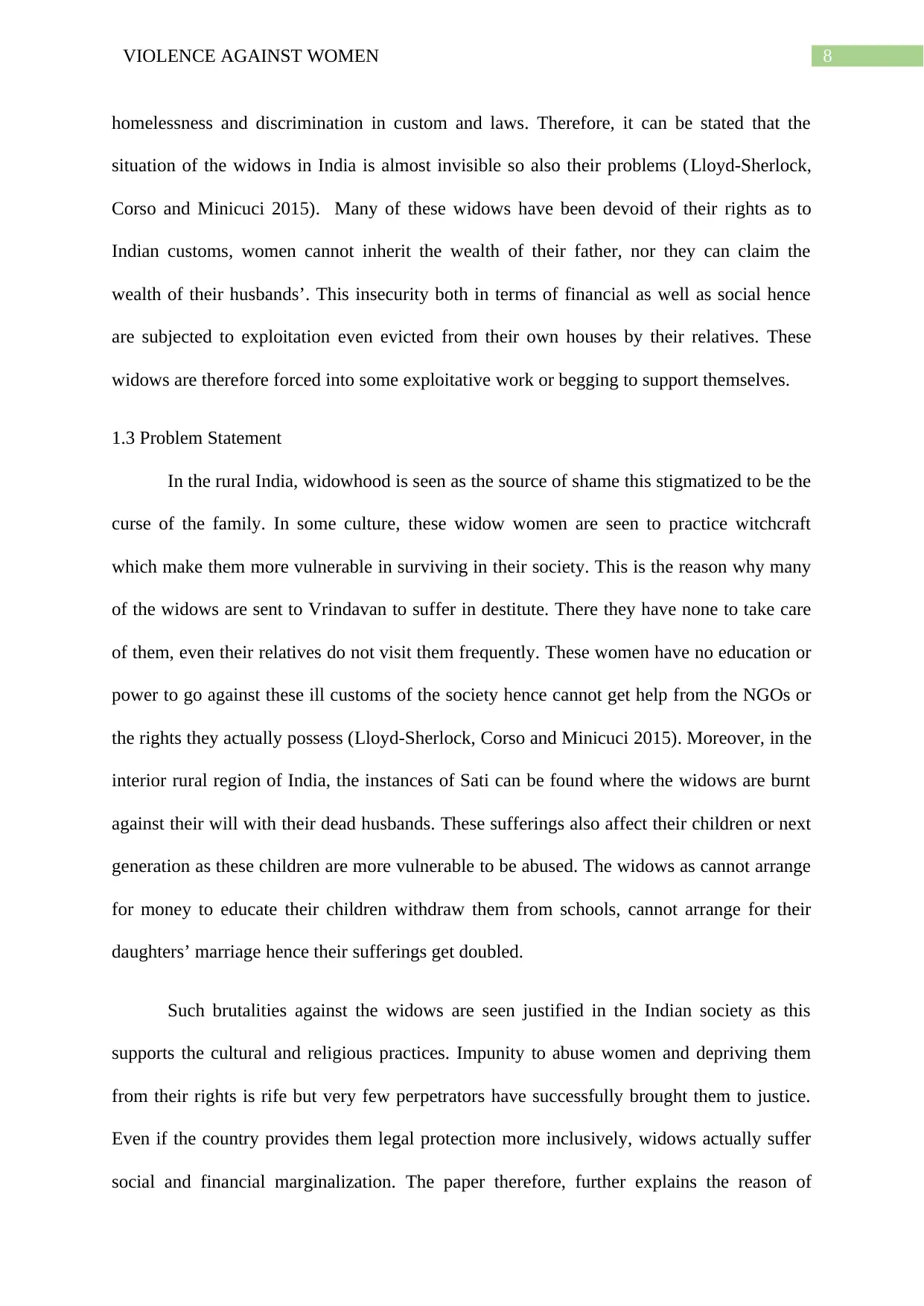
8VIOLENCE AGAINST WOMEN
homelessness and discrimination in custom and laws. Therefore, it can be stated that the
situation of the widows in India is almost invisible so also their problems (Lloyd-Sherlock,
Corso and Minicuci 2015). Many of these widows have been devoid of their rights as to
Indian customs, women cannot inherit the wealth of their father, nor they can claim the
wealth of their husbands’. This insecurity both in terms of financial as well as social hence
are subjected to exploitation even evicted from their own houses by their relatives. These
widows are therefore forced into some exploitative work or begging to support themselves.
1.3 Problem Statement
In the rural India, widowhood is seen as the source of shame this stigmatized to be the
curse of the family. In some culture, these widow women are seen to practice witchcraft
which make them more vulnerable in surviving in their society. This is the reason why many
of the widows are sent to Vrindavan to suffer in destitute. There they have none to take care
of them, even their relatives do not visit them frequently. These women have no education or
power to go against these ill customs of the society hence cannot get help from the NGOs or
the rights they actually possess (Lloyd-Sherlock, Corso and Minicuci 2015). Moreover, in the
interior rural region of India, the instances of Sati can be found where the widows are burnt
against their will with their dead husbands. These sufferings also affect their children or next
generation as these children are more vulnerable to be abused. The widows as cannot arrange
for money to educate their children withdraw them from schools, cannot arrange for their
daughters’ marriage hence their sufferings get doubled.
Such brutalities against the widows are seen justified in the Indian society as this
supports the cultural and religious practices. Impunity to abuse women and depriving them
from their rights is rife but very few perpetrators have successfully brought them to justice.
Even if the country provides them legal protection more inclusively, widows actually suffer
social and financial marginalization. The paper therefore, further explains the reason of
homelessness and discrimination in custom and laws. Therefore, it can be stated that the
situation of the widows in India is almost invisible so also their problems (Lloyd-Sherlock,
Corso and Minicuci 2015). Many of these widows have been devoid of their rights as to
Indian customs, women cannot inherit the wealth of their father, nor they can claim the
wealth of their husbands’. This insecurity both in terms of financial as well as social hence
are subjected to exploitation even evicted from their own houses by their relatives. These
widows are therefore forced into some exploitative work or begging to support themselves.
1.3 Problem Statement
In the rural India, widowhood is seen as the source of shame this stigmatized to be the
curse of the family. In some culture, these widow women are seen to practice witchcraft
which make them more vulnerable in surviving in their society. This is the reason why many
of the widows are sent to Vrindavan to suffer in destitute. There they have none to take care
of them, even their relatives do not visit them frequently. These women have no education or
power to go against these ill customs of the society hence cannot get help from the NGOs or
the rights they actually possess (Lloyd-Sherlock, Corso and Minicuci 2015). Moreover, in the
interior rural region of India, the instances of Sati can be found where the widows are burnt
against their will with their dead husbands. These sufferings also affect their children or next
generation as these children are more vulnerable to be abused. The widows as cannot arrange
for money to educate their children withdraw them from schools, cannot arrange for their
daughters’ marriage hence their sufferings get doubled.
Such brutalities against the widows are seen justified in the Indian society as this
supports the cultural and religious practices. Impunity to abuse women and depriving them
from their rights is rife but very few perpetrators have successfully brought them to justice.
Even if the country provides them legal protection more inclusively, widows actually suffer
social and financial marginalization. The paper therefore, further explains the reason of
⊘ This is a preview!⊘
Do you want full access?
Subscribe today to unlock all pages.

Trusted by 1+ million students worldwide
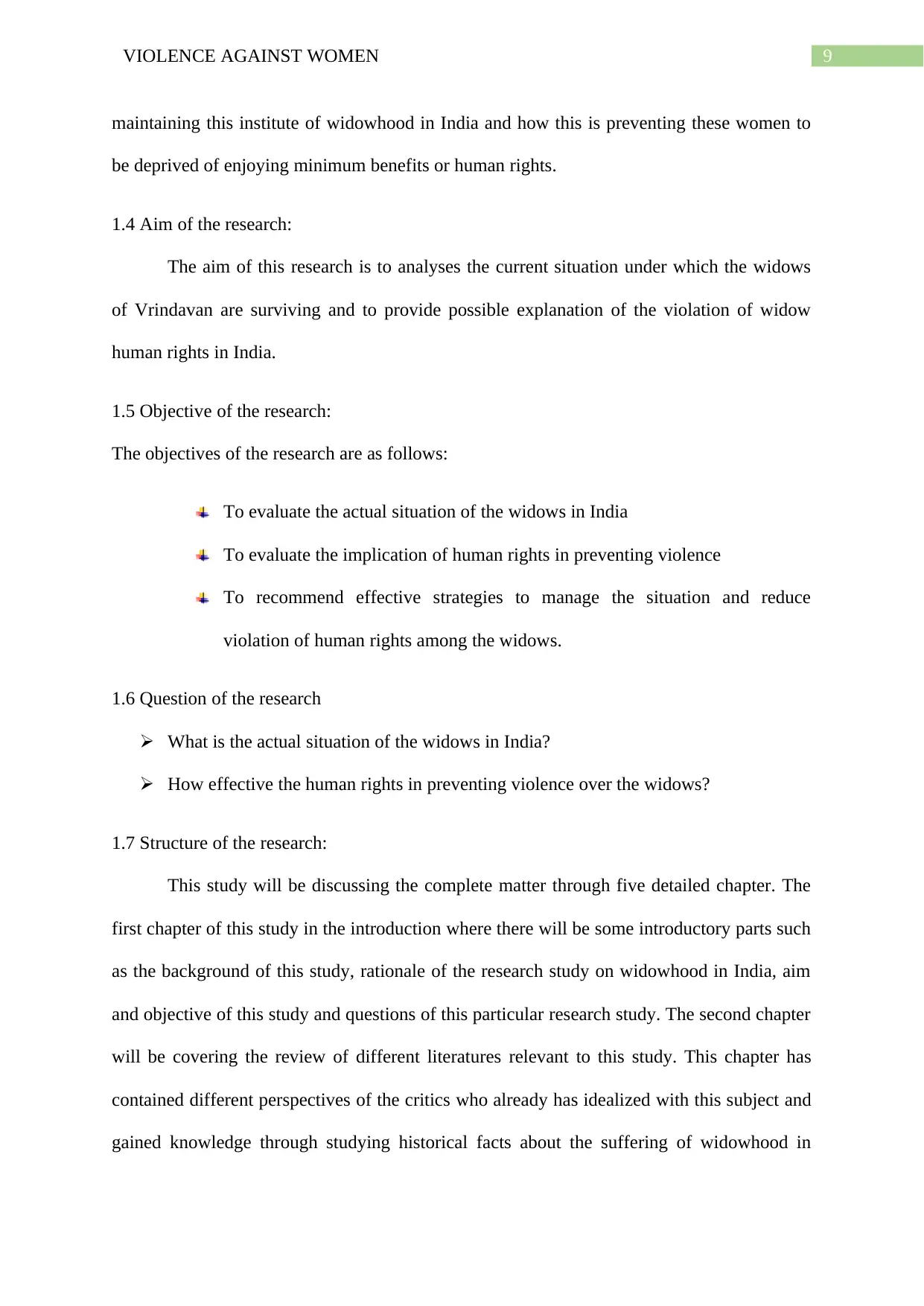
9VIOLENCE AGAINST WOMEN
maintaining this institute of widowhood in India and how this is preventing these women to
be deprived of enjoying minimum benefits or human rights.
1.4 Aim of the research:
The aim of this research is to analyses the current situation under which the widows
of Vrindavan are surviving and to provide possible explanation of the violation of widow
human rights in India.
1.5 Objective of the research:
The objectives of the research are as follows:
To evaluate the actual situation of the widows in India
To evaluate the implication of human rights in preventing violence
To recommend effective strategies to manage the situation and reduce
violation of human rights among the widows.
1.6 Question of the research
What is the actual situation of the widows in India?
How effective the human rights in preventing violence over the widows?
1.7 Structure of the research:
This study will be discussing the complete matter through five detailed chapter. The
first chapter of this study in the introduction where there will be some introductory parts such
as the background of this study, rationale of the research study on widowhood in India, aim
and objective of this study and questions of this particular research study. The second chapter
will be covering the review of different literatures relevant to this study. This chapter has
contained different perspectives of the critics who already has idealized with this subject and
gained knowledge through studying historical facts about the suffering of widowhood in
maintaining this institute of widowhood in India and how this is preventing these women to
be deprived of enjoying minimum benefits or human rights.
1.4 Aim of the research:
The aim of this research is to analyses the current situation under which the widows
of Vrindavan are surviving and to provide possible explanation of the violation of widow
human rights in India.
1.5 Objective of the research:
The objectives of the research are as follows:
To evaluate the actual situation of the widows in India
To evaluate the implication of human rights in preventing violence
To recommend effective strategies to manage the situation and reduce
violation of human rights among the widows.
1.6 Question of the research
What is the actual situation of the widows in India?
How effective the human rights in preventing violence over the widows?
1.7 Structure of the research:
This study will be discussing the complete matter through five detailed chapter. The
first chapter of this study in the introduction where there will be some introductory parts such
as the background of this study, rationale of the research study on widowhood in India, aim
and objective of this study and questions of this particular research study. The second chapter
will be covering the review of different literatures relevant to this study. This chapter has
contained different perspectives of the critics who already has idealized with this subject and
gained knowledge through studying historical facts about the suffering of widowhood in
Paraphrase This Document
Need a fresh take? Get an instant paraphrase of this document with our AI Paraphraser
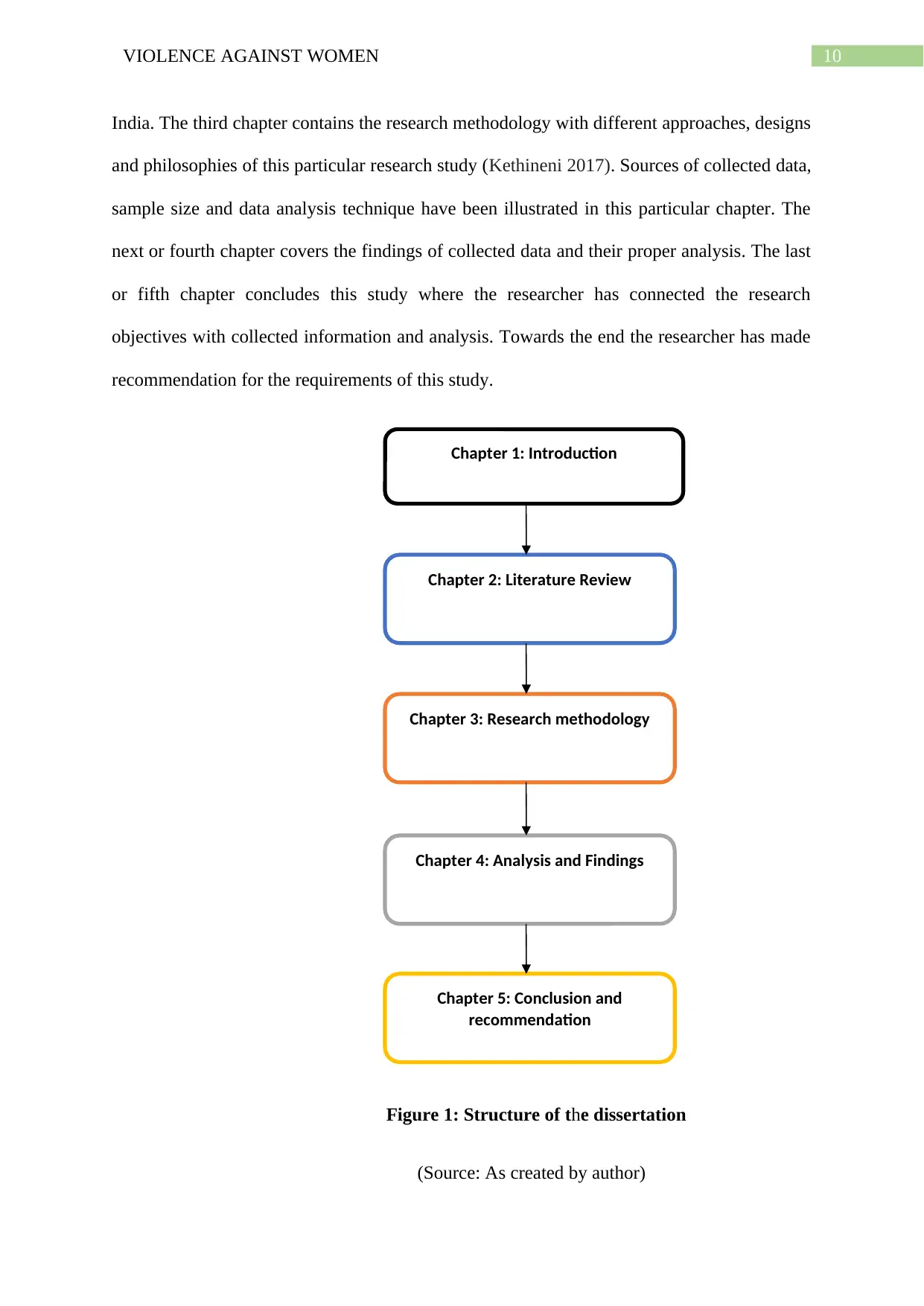
10VIOLENCE AGAINST WOMEN
India. The third chapter contains the research methodology with different approaches, designs
and philosophies of this particular research study (Kethineni 2017). Sources of collected data,
sample size and data analysis technique have been illustrated in this particular chapter. The
next or fourth chapter covers the findings of collected data and their proper analysis. The last
or fifth chapter concludes this study where the researcher has connected the research
objectives with collected information and analysis. Towards the end the researcher has made
recommendation for the requirements of this study.
Figure 1: Structure of the dissertation
(Source: As created by author)
Chapter 1: Introduction
Chapter 2: Literature Review
Chapter 3: Research methodology
Chapter 4: Analysis and Findings
Chapter 5: Conclusion and
recommendation
India. The third chapter contains the research methodology with different approaches, designs
and philosophies of this particular research study (Kethineni 2017). Sources of collected data,
sample size and data analysis technique have been illustrated in this particular chapter. The
next or fourth chapter covers the findings of collected data and their proper analysis. The last
or fifth chapter concludes this study where the researcher has connected the research
objectives with collected information and analysis. Towards the end the researcher has made
recommendation for the requirements of this study.
Figure 1: Structure of the dissertation
(Source: As created by author)
Chapter 1: Introduction
Chapter 2: Literature Review
Chapter 3: Research methodology
Chapter 4: Analysis and Findings
Chapter 5: Conclusion and
recommendation
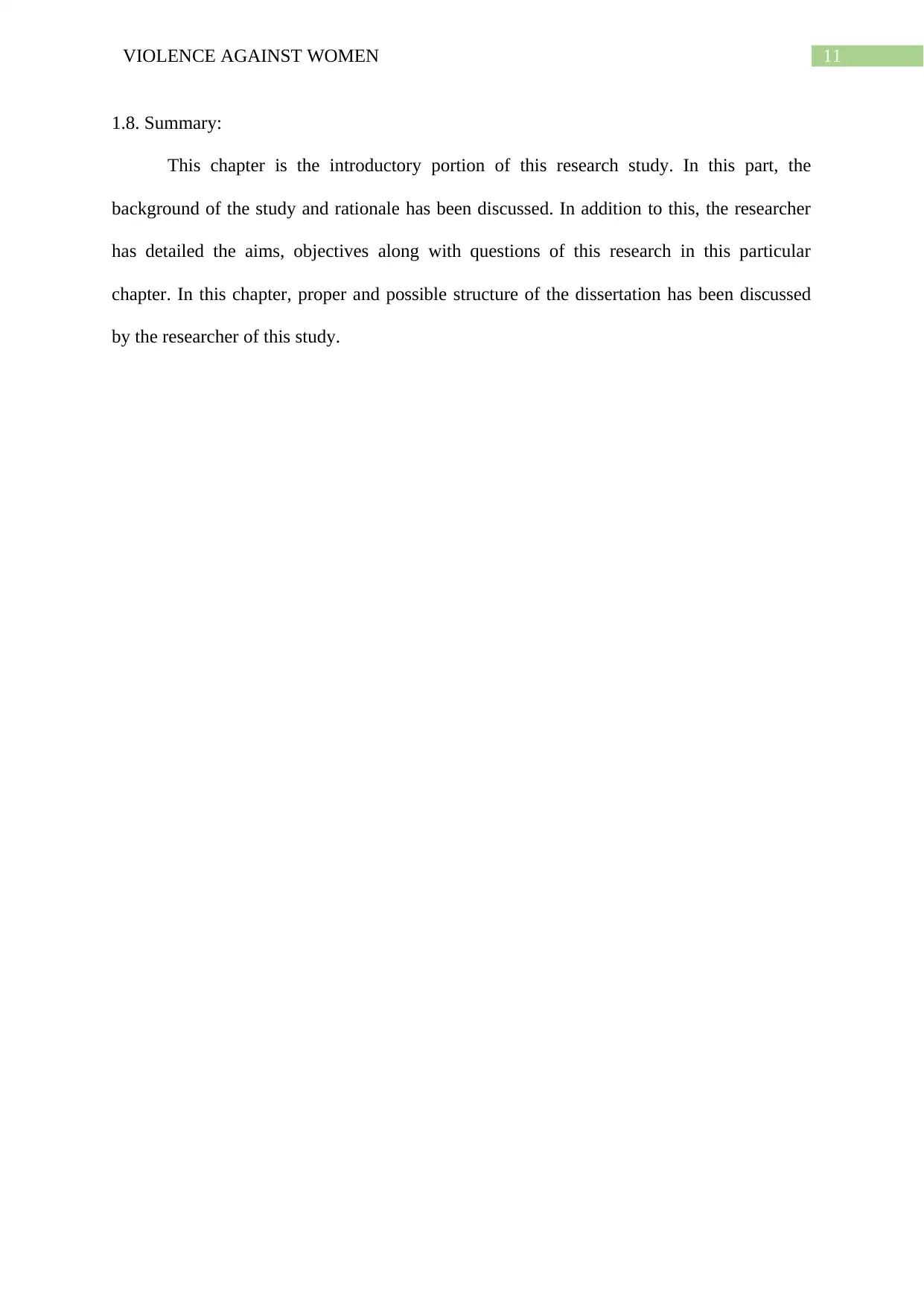
11VIOLENCE AGAINST WOMEN
1.8. Summary:
This chapter is the introductory portion of this research study. In this part, the
background of the study and rationale has been discussed. In addition to this, the researcher
has detailed the aims, objectives along with questions of this research in this particular
chapter. In this chapter, proper and possible structure of the dissertation has been discussed
by the researcher of this study.
1.8. Summary:
This chapter is the introductory portion of this research study. In this part, the
background of the study and rationale has been discussed. In addition to this, the researcher
has detailed the aims, objectives along with questions of this research in this particular
chapter. In this chapter, proper and possible structure of the dissertation has been discussed
by the researcher of this study.
⊘ This is a preview!⊘
Do you want full access?
Subscribe today to unlock all pages.

Trusted by 1+ million students worldwide
1 out of 68
Related Documents
Your All-in-One AI-Powered Toolkit for Academic Success.
+13062052269
info@desklib.com
Available 24*7 on WhatsApp / Email
![[object Object]](/_next/static/media/star-bottom.7253800d.svg)
Unlock your academic potential
Copyright © 2020–2025 A2Z Services. All Rights Reserved. Developed and managed by ZUCOL.





